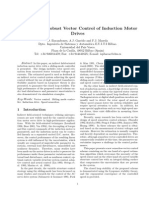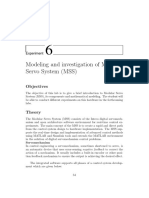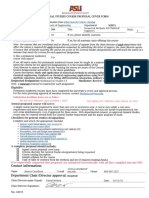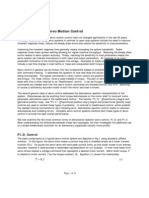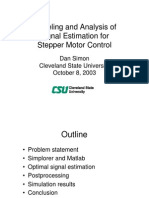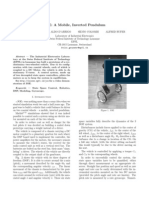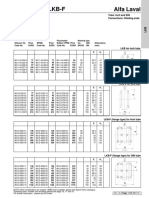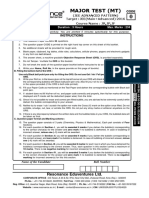Crank Arm Kinematics
Crank Arm Kinematics
Uploaded by
Noor Nabi MujahidCopyright:
Available Formats
Crank Arm Kinematics
Crank Arm Kinematics
Uploaded by
Noor Nabi MujahidOriginal Description:
Copyright
Available Formats
Share this document
Did you find this document useful?
Is this content inappropriate?
Copyright:
Available Formats
Crank Arm Kinematics
Crank Arm Kinematics
Uploaded by
Noor Nabi MujahidCopyright:
Available Formats
Application Note
Nov-2004
Crank-Arm Kinematics
Crank-arm mechanisms are used in many devices to convert rotary motion into reciprocating linear motion. Presses involving crank arms are starting to use servo motors to provide greater flexibility in the press cycles they provide. Many users would like to program these devices directly in terms of the linear dimension, not of the underlying rotary crank angle. Turbo PMACs kinematic algorithms permit this method of programming by automatically computing the transformation between the linear end-effector position and the rotary crank angle. The geometry in this mechanism is quite simple. The trickiest aspect of the kinematics algorithms is to decide which of the two possible crank angles should be used for a given end-effector position. There are many possible methods for making this decision; in this example we make the choice that minimizes crank-wheel acceleration.
Mechanism Description
The mechanism has an arm of length L attached by a pivoting joint at one end to an end-effector that is constrained to move in only one direction with the line between this pivot and the center of the crank collinear with the motion of the end-effector. At the other end of the arm is a pivot joint connecting the arm to the rotating crank wheel at a distance R from the center of the crank wheel. The crank wheel is driven by a servo motor.
R X
Forward Kinematics
In the forward kinematics, we want to compute the linear X position from the rotary position. We start with the law of cosines for the triangle with sides of lengths R, L and X:
L2 = X 2 + R 2 2 RX cos
We convert this to a quadratic equation in X, and solve:
X 2 2 R cos X + R 2 L2 = 0
X = R cos R 2 cos 2 R 2 + L2
Due to the physical constraints the arm can only go out to the right in our drawing only the positive solution is valid. The following setup and program can be used to implement the forward kinematics: Macro Substitution Definitions Status/control bits using suggested M-variable definitions
#define Mtr1Homed M145 Mtr1Homed->Y:$0000C0,10,1 #define CS1RunTimeErr M5182 CS1RunTimeErr->Y:$00203F,22,1 ; ; ; ; Motor 1 home complete bit Bit 10 in Motor 1 status word CS 1 run-time error bit Bit 22 in C.S. 1 status word
Crank Arm Kinematics Example
Nov-2004
Application Note
Definitions to Variables with Fixed Functions
#define Mtr1KinPos P1 #define XkinPos Q7 #define #define #define #define #define #define #define I15=0 I5150=1 Mtr1Scale=200 Rad=400 Len=750 L2MinR2=Len*Len-Rad*Rad Mtr1Scale Q120 Rad Q121 Len Q122 L2MinR2 Q123 Theta Q124 CosTheta Q125 Dtheta Q126 ; #1 pos in cts for kinematics ; X-axis pos in deg for kin ; ; ; ; ; ; ; Counts per degree of crank Radius of crank Length of crank arm Len^2 Rad^2 Intermediate angle term Intermediate trig term Velocity term
Definitions to Variables with Open Functions
Setup for Program
; Trig calcs in degrees ; Enable kinematics for C.S.1 ; ; ; ; Counts per degree mm mm Pre-compute for efficiency
Compute System Constants (these may go in power-on PLC)
Forward Kinematic Program Buffer for Repeated Execution
&1 OPEN FORWARD CLEAR IF(Mtr1Homed=1) ; Valid position reference? Theta=(Mtr1KinPos/Mtr1Scale)%-180 CosTheta=COS(Theta) ; Compute once for efficiency XKinPos=Rad*CosTheta+SQRT(Rad*Rad*CosTheta*CosTheta-L2MinR2) DTheta=0 ; Starts at zero velocity ENDIF CLOSE
This forward-kinematics program will be executed automatically every time Coordinate System 1 starts a motion program. It can also be executed on a PMATCH command. Note that variables Theta and DTheta are computed and stored for use by the inverse kinematic program.
Inverse Kinematics
In the inverse kinematics, we want to compute the rotary position from the linear X position. We rearrange the law-of-cosine equation used in the forward kinematics to isolate and solve for :
2 RX cos = X 2 + R 2 L2
cos =
X 2 + R 2 L2 2 RX X 2 + R 2 L2 2 RX
= cos 1
Here, both the positive and negative arc-cosine solutions are potentially valid, and we must devise a method to choose between them. In this example, we will choose the solution that produces the lowest acceleration in . When we are not close to 0 or 180 degrees, this strategy will keep us on the same side (as would choosing the lowest velocity). As we pass through 0 or 180 degrees, this will keep us moving in the same direction (using the lowest velocity would not necessarily do this). Because the crank wheel can rotate many revolutions, we cannot simply use the arc-cosine solution. Instead, we must extend this value by computing the change in angle, and adding this to an accumulated multi-turn angle.
Crank Arm Kinematics Example
Application Note
Nov-2004
Additional Definitions for Inverse Kinematic Program
#define #define #define #define #define #define &1 #1->I ThetaP Q131 ThetaM Q132 DthetaP Q133 DthetaM Q134 D2ThetaP Q135 D2ThetaM Q136 ; ; ; ; ; ; Possible Possible Velocity Velocity Accel if Accel if positive soln negative soln if positive soln if negative soln positive soln negative soln
Additional Setup for Inverse Kinematic Program
; Motor 1 assigned to inverse kinematic axis ; in CS 1 ; Solve inv. kin. every 10 msec
I5113=10 &1 OPEN INVERSE CLEAR CosTheta=(XKinPos*XKinPos-L2MinR2)/(2*Rad*XKinPos) IF(CosTheta!>1.0 AND CosTheta!<-1.0) ; Valid position? ThetaP=ACOS(CosTheta) ; Tentative positive soln ThetaM=-ThetaP ; Tentative negative soln DThetaP=(ThetaP-Theta)%-180 ; Velocity for positive soln DThetaM=(ThetaM-Theta)%-180 ; Velocity for negative soln D2ThetaP=DThetaP-DTheta ; Accel for positive soln D2ThetaM=DThetaM-DTheta ; Accel for negative soln IF(ABS(D2ThetaP)<ABS(D2ThetaM)) ; Use positive soln Theta=ThetaP ; Select and save for next cycle DTheta=DThetaP ; Select and save for next cycle ELSE ; Use negative soln Theta=ThetaM ; Select and save for next cycle DTheta=DThetaM ; Select and save for next cycle ENDIF Mtr1KinPos=Mtr1KinPos+DTheta*Mtr1Scale ; Accumulated angle ELSE ; Command out of range CS1RunTimeErr=1 ; Set to stop ENDIF CLOSE
Note that by selecting the positive solution only if its resulting acceleration is less than the acceleration for the negative solution, when we start from a stop at 0o or 180o, we will choose the negative solution. If we had used the !> (not greater than) comparator instead of the < (less than) comparator, we would have chosen the positive solutions in these cases instead.
Crank Arm Kinematics Example
You might also like
- Workshop 4 - Draft2Document6 pagesWorkshop 4 - Draft2Saatwick MathurNo ratings yet
- Modelado Rotary Pendulum Workbook InstructorDocument60 pagesModelado Rotary Pendulum Workbook Instructorsolid34100% (1)
- Osmonics Tonkaflo Pumps Ss Series: Installation, Operation, and Maintenance ManualDocument43 pagesOsmonics Tonkaflo Pumps Ss Series: Installation, Operation, and Maintenance ManualLeopoldo Ulloa100% (1)
- Fundamentals of PoroelasticityDocument96 pagesFundamentals of PoroelasticityTaisa PachecoNo ratings yet
- Experiment 106. Stabilisation of A Rotary Inverted Pendulum 1 ObjectiveDocument11 pagesExperiment 106. Stabilisation of A Rotary Inverted Pendulum 1 ObjectiveAmine Y. AlamiNo ratings yet
- A Sensorless Robust Vector Control of Induction Motor DrivesDocument6 pagesA Sensorless Robust Vector Control of Induction Motor DrivesLava KumarNo ratings yet
- BTP II Part2Document12 pagesBTP II Part2Sanskriti BhansaliNo ratings yet
- Inverse KinematicsDocument17 pagesInverse KinematicsLabo DolonNo ratings yet
- Transm Dynamics and ControlDocument17 pagesTransm Dynamics and ControlTimon2005100% (1)
- FYP PresentationDocument81 pagesFYP PresentationTarek Bmr100% (1)
- LCS 6th Lab ManualDocument12 pagesLCS 6th Lab ManualWaleed QureshiNo ratings yet
- Four-Quadrant Control of A Switched Reluctance Motor For A Highly Dynamic Actuator LoadDocument7 pagesFour-Quadrant Control of A Switched Reluctance Motor For A Highly Dynamic Actuator LoadAshwin RamanujamNo ratings yet
- Speed Control of DC Servo Motor Using PIDocument26 pagesSpeed Control of DC Servo Motor Using PIUjjawal DarvaikarNo ratings yet
- Research and Apply PID Hybrid Fuzzy Control TechnologyDocument6 pagesResearch and Apply PID Hybrid Fuzzy Control TechnologyhoangepuNo ratings yet
- Antenna Azimuth and Its Simulation by Lab View Program: School of Electrical and Electronoic EngineeringDocument25 pagesAntenna Azimuth and Its Simulation by Lab View Program: School of Electrical and Electronoic EngineeringKenneth CastroNo ratings yet
- Rotor Flux Based MRASDocument6 pagesRotor Flux Based MRASMastan ReddyNo ratings yet
- Interpolation Technique For Encoder Resolution Improvement in Permanent Magnet Synchronous Motor Drives PDFDocument6 pagesInterpolation Technique For Encoder Resolution Improvement in Permanent Magnet Synchronous Motor Drives PDFarenasjaNo ratings yet
- Objective of My ProjectDocument15 pagesObjective of My Projectk sai krishnaNo ratings yet
- IECON22 Standstill Flux EstimationDocument6 pagesIECON22 Standstill Flux EstimationvawihNo ratings yet
- 4445 UjlkjDocument6 pages4445 UjlkjAjay ChandranNo ratings yet
- Control of Inverted PendulumDocument5 pagesControl of Inverted PendulumalfredccNo ratings yet
- EET304 - M3 Ktunotes - inDocument47 pagesEET304 - M3 Ktunotes - inAkhilaNo ratings yet
- Inverted Pendulum Design With Hardware Fuzzy Logic ControllerDocument6 pagesInverted Pendulum Design With Hardware Fuzzy Logic ControlleranonymousxxNo ratings yet
- Mathematical StudiesDocument56 pagesMathematical StudiesOayes MiddaNo ratings yet
- ACS Lab Exp 1Document10 pagesACS Lab Exp 1620978vkNo ratings yet
- Rotary Double Inverted Pendulum - Laboratory GuideDocument21 pagesRotary Double Inverted Pendulum - Laboratory GuideSaqib KhattakNo ratings yet
- Kinematic Analysis of Different RobotsDocument16 pagesKinematic Analysis of Different Robotsk sai krishnaNo ratings yet
- Modeling and Simulation For Adaptive Control of Quadcopters: Me - 440 Major ProjectDocument31 pagesModeling and Simulation For Adaptive Control of Quadcopters: Me - 440 Major ProjectNikhil JayanthNo ratings yet
- CT Final2Document7 pagesCT Final2Ria RamachandranNo ratings yet
- Combining The Principles of Variable Structure, Direct Torque Control, and Space Vector Modulation For Induction Motor Fed by Matrix ConverterDocument7 pagesCombining The Principles of Variable Structure, Direct Torque Control, and Space Vector Modulation For Induction Motor Fed by Matrix ConverterGacem AminaNo ratings yet
- Adaptive Dynamic Inversion Control With Actuator Saturation Constraints Applied To Tracking Spacecraft ManeuversDocument10 pagesAdaptive Dynamic Inversion Control With Actuator Saturation Constraints Applied To Tracking Spacecraft Maneuversdursun_ufukNo ratings yet
- Disturbance Accommodating LQR Method Based Pitch Control Strategy For Wind TurbinesDocument5 pagesDisturbance Accommodating LQR Method Based Pitch Control Strategy For Wind TurbinesStefania OliveiraNo ratings yet
- CORDICDocument8 pagesCORDICRofaelEmilNo ratings yet
- Servo FundamentalsDocument11 pagesServo Fundamentalsapi-3797895No ratings yet
- 03 2008 JA PS A 1 008 CleanDocument6 pages03 2008 JA PS A 1 008 CleanBentarfa IslamNo ratings yet
- QNET-ROTPEN Exp04-Inv Pendulum StudentDocument37 pagesQNET-ROTPEN Exp04-Inv Pendulum StudentMeta Tum0% (1)
- Novel Modeling and Damping Technique For Hybrid Stepper MotorDocument6 pagesNovel Modeling and Damping Technique For Hybrid Stepper MotorVashik BedasieNo ratings yet
- Forward and Inverse KinematicsDocument45 pagesForward and Inverse KinematicsNazlıcan DönmezNo ratings yet
- Ee 331 Design - Servo MotorDocument5 pagesEe 331 Design - Servo MotorLa-Pierre O'MeallyNo ratings yet
- SCARA Robot KinematicsDocument5 pagesSCARA Robot KinematicsPrasanth Kurapati75% (4)
- New DTC WRKDocument8 pagesNew DTC WRKNAENWI YAABARINo ratings yet
- I Jfs 2281328905800Document12 pagesI Jfs 2281328905800Tawhid Bin TarekNo ratings yet
- Mechanics of Machines ProjectDocument18 pagesMechanics of Machines ProjectSheikh Mohamed NaimNo ratings yet
- Project ReportDocument15 pagesProject ReportFaIz FauziNo ratings yet
- Sliding Mode Brushless DC Motor Current Torque Control AlgorithmsDocument6 pagesSliding Mode Brushless DC Motor Current Torque Control Algorithmscarolain_msNo ratings yet
- Csu Dan SimonDocument36 pagesCsu Dan SimonUttam MNNo ratings yet
- CS W4 EV3 v2 PDFDocument3 pagesCS W4 EV3 v2 PDFhamalNo ratings yet
- Constrained Predictive Control of A Servo-Driven Tracking TurretDocument6 pagesConstrained Predictive Control of A Servo-Driven Tracking TurretVu Duc TruongNo ratings yet
- Paper Title: Ajay Kumar Gudla and Saikat ChakrabartiDocument5 pagesPaper Title: Ajay Kumar Gudla and Saikat ChakrabartiAshutosh KumarNo ratings yet
- ME389 MEM04 PendulumGantry GuidelineDocument14 pagesME389 MEM04 PendulumGantry GuidelineTarikuNo ratings yet
- Sensorless Control of Permanent Magnet Synchronous Motor With Stator Flux EstimationDocument5 pagesSensorless Control of Permanent Magnet Synchronous Motor With Stator Flux EstimationPhước Linh TrầnNo ratings yet
- Multiple Controllers For Boost Converters Under Large Load Range: A GA and Fuzzy Logic Based ApproachDocument6 pagesMultiple Controllers For Boost Converters Under Large Load Range: A GA and Fuzzy Logic Based ApproachDaltonVidorNo ratings yet
- Christophgruber Mechatronics2012Document8 pagesChristophgruber Mechatronics2012Hamza NasirNo ratings yet
- Twin Rotor Mimo System: Experiment No: 5Document8 pagesTwin Rotor Mimo System: Experiment No: 5sameer sultanNo ratings yet
- Grasser Darrigo Colombi Rufer Mic 01Document6 pagesGrasser Darrigo Colombi Rufer Mic 01mahmudahmadiNo ratings yet
- Analog Dialogue, Volume 48, Number 1: Analog Dialogue, #13From EverandAnalog Dialogue, Volume 48, Number 1: Analog Dialogue, #13Rating: 4 out of 5 stars4/5 (1)
- Control of DC Motor Using Different Control StrategiesFrom EverandControl of DC Motor Using Different Control StrategiesNo ratings yet
- Reference Guide To Useful Electronic Circuits And Circuit Design Techniques - Part 2From EverandReference Guide To Useful Electronic Circuits And Circuit Design Techniques - Part 2No ratings yet
- Electronic Automotive Transmission Troubleshooter Nissan-Infinity VehiclesFrom EverandElectronic Automotive Transmission Troubleshooter Nissan-Infinity VehiclesNo ratings yet
- Robot Manipulators: Modeling, Performance Analysis and ControlFrom EverandRobot Manipulators: Modeling, Performance Analysis and ControlNo ratings yet
- 11b Kernel StorageDocument7 pages11b Kernel Storagehaiqal marizanNo ratings yet
- Cast-in-Place Concrete & Pre-Cast Concrete: Building Technology 5Document57 pagesCast-in-Place Concrete & Pre-Cast Concrete: Building Technology 5Carmela RegultoNo ratings yet
- Kamsons Chemicals Pvt. LTD.: Technical Data Sheet KAMICRYL-400Document1 pageKamsons Chemicals Pvt. LTD.: Technical Data Sheet KAMICRYL-400Swapnil AlandNo ratings yet
- DDL-9000cs Series Engineers ManualDocument198 pagesDDL-9000cs Series Engineers ManualfilisavicNo ratings yet
- Alfa Laval LKB, Lkb-2, LKB-F: Butterfly ValvesDocument15 pagesAlfa Laval LKB, Lkb-2, LKB-F: Butterfly ValvesJosé Luis RomeroNo ratings yet
- PC450 450LC-7Document7 pagesPC450 450LC-7komatsuequipmentNo ratings yet
- Rahul Resume PDFDocument2 pagesRahul Resume PDFRahul Raghukumar100% (1)
- Anonymized Escalation Matrix (AEM)Document2 pagesAnonymized Escalation Matrix (AEM)साखरे शुभमNo ratings yet
- Manufacturing Processes For Engineering Materials: (5 Edition in SI Units)Document17 pagesManufacturing Processes For Engineering Materials: (5 Edition in SI Units)svkindiaNo ratings yet
- Advance Mechnics of Machines M Tech BasicsDocument63 pagesAdvance Mechnics of Machines M Tech BasicsMohammedRafeeq100% (2)
- Lecture 1 - Construction of Synchronous GeneratorDocument11 pagesLecture 1 - Construction of Synchronous GeneratorNdapewelao Mbwale100% (1)
- Out Put Details and ExamplesDocument208 pagesOut Put Details and ExamplesLucio100No ratings yet
- Pawan Kumar BT - 7B Roll - 1736608028Document9 pagesPawan Kumar BT - 7B Roll - 1736608028Pawan kumarNo ratings yet
- Voltage Detector Using BC547 TransistorDocument7 pagesVoltage Detector Using BC547 TransistorNadeemNo ratings yet
- Explo 1379Document5 pagesExplo 1379Invasi Digital ExpressindoNo ratings yet
- Elide Fire Revolutionary Automatic Extinguishing BallDocument2 pagesElide Fire Revolutionary Automatic Extinguishing BallAzfast Asia Pte LtdNo ratings yet
- PDS SIS LogicSolverDocument14 pagesPDS SIS LogicSolverlimresNo ratings yet
- Part JDocument73 pagesPart JOlivia SaferNo ratings yet
- Hyva_Grua__hb60---7880697.0--spare-parts-catalogue--ingDocument260 pagesHyva_Grua__hb60---7880697.0--spare-parts-catalogue--ingjorgesousa87No ratings yet
- sm-ts3 p7-8 Howtocheck PDFDocument2 pagessm-ts3 p7-8 Howtocheck PDFnvn87No ratings yet
- Introduction To DC GeneratorDocument119 pagesIntroduction To DC GeneratorFaraz HussainNo ratings yet
- Mercedes Tech Specs 3341 6x4Document3 pagesMercedes Tech Specs 3341 6x4Habisco LtdNo ratings yet
- DuctSox Opti X Fabric SheetDocument1 pageDuctSox Opti X Fabric Sheetjeruel sabacanNo ratings yet
- Flash Ecolabel SutterDocument14 pagesFlash Ecolabel SutterMohammed SamyNo ratings yet
- Section 15540 Hvac Pumps PDFDocument6 pagesSection 15540 Hvac Pumps PDFkdpmansiNo ratings yet
- Resonance DPPDocument25 pagesResonance DPPSurya Prakash67% (3)
- Vedic Maths TutorialDocument15 pagesVedic Maths Tutorialsivashankari1100% (1)
- Analogy and Classification (Figure Based)Document4 pagesAnalogy and Classification (Figure Based)Mohit SinghNo ratings yet





